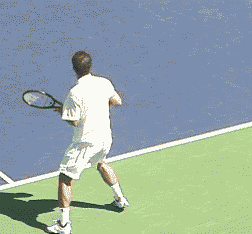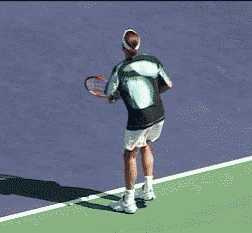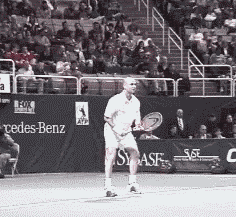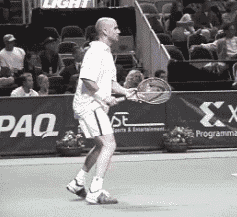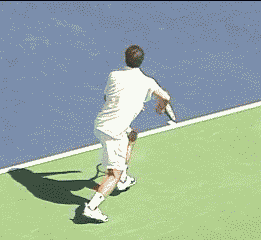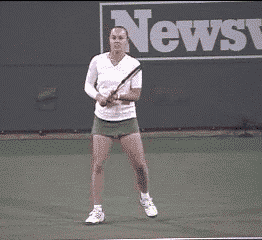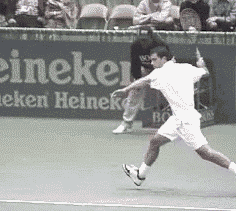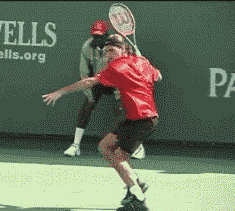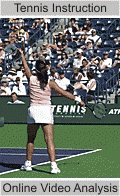|
TennisOne Lessons
The Running Forehand It can take your game to the next level by Heath Waters After coaching beginner to advanced juniors for many years and coaching on the professional tour for the past 8 years, I have come to an enlightening conclusion. One of the distinct differences separating a player from the next higher level, whether it be a 3.0 from 3.5, or a top 300 ranked pro player from a top 50 ranked pro player, is how well the player strikes the ball when they are out of their comfort zone.
Comfort Zone We will define comfort zone as that normal, relatively stationary hitting position where you can easily set up and make a complete transfer of weight into the ball with optimal balance. So, to be outside one's comfort zone, is to be for the most part, on the run. How well a player hits the ball when they are “on the run” can, on the pro level, well mean the difference between top 300 and top 50. In this article we will examine the best running forehands in the world, break down the technique into three easy to learn steps, and then show you how to apply the fundamentals of these steps to your own forehand so that you can take your game to that next level. Is there more than one factor that can determine whether your tennis game goes to the next level or not? The answer of course is yes. The mental game, tactics, physical strength, stamina etc, are but a few worth mentioning, however, one factor that players and coaches alike rarely work on enough are the running groundstrokes. Most players when practicing typically rally back and forth across the net while hitting down the middle, crosscourt, playing games, sets or drills. This is fine and very much necessary, but how often do you actually practice specifically hitting on the run groundstrokes? Most coaches and players from my experience assume hitting on the run is an instinctual reaction that seems to occur naturally. For some this assumption is partly true as some players do instinctually hit well on the run without even being taught. However, for the vast majority of us this is not a natural instinct and we need to rely on good old proper technique. Yep that is right, there actually is a very specific and different technique for hitting an on the run forehand as opposed to a stationary forehand.
When you think of Pete Sampras' tennis game what comes to mind? The serve? Yes, one of the all time great serves, but Pete Sampras is the player who took his on the run forehand from being merely a defensive or neutralizing shot and developed it into his biggest groundstroke weapon. He loved this shot so much so that he baited opponents, teased them with dinky cross-court slice backhands, and dared them to hit down the line, so he could strike with the running forehand. If an opponent took the bait he would punish them severely ripping winner after winner with his patented ¾ angle cross-court running forehand target. Then, just when they started covering the cross-court angle he would smash the ball down the line for a winner. Where the typical tour player mentality was to hit defensive or neutralizing running forehands in order to give them time to get back into good court position to continue a rally, Sampras took what seemed to everyone else to be a weak defensive position and turned his running forehand into the most dominating groundstroke weapon of the 90's. Along with his serve his running forehand was one of the most feared shots in tennis history. So lets break this technique down and learn how to apply it to your own game. We will mainly use Sampras and Federer's running forehands as examples as they share the same fundamental commonalities that sets them apart from their rivals. The Split Step Although Andre Agassi is my favorite ball striker of all time, his on the run footwork could be much more efficient. We will therefore use his running footwork technique to contrast the more efficient superior footwork of Sampras and Federer.
Above, notice the differences in the split steps of Sampras and Federer compared to that of Agassi. When coming out of the split step into the landing, Sampras and Federer do not touch the ground with their right foot at the same time their left foot touches the ground. However, both the right foot and left foot of Agassi land on the ground at the same time. Why is this so important? For a couple of reasons. The first is the split step timing. Sampras and Federer have timed their split step properly. This is demonstrated by landing only on the one foot (the left foot) first. The left foot is used as a spring action to burst towards the direction of the flight path of the ball hence the term burst and glide. This is what I mean by getting a jump-start on the ball. The second reason this is important is that Sampras and Federer are gaining an ever so precious step towards the flight path of the ball by taking a step with their right foot towards the ball before the right foot lands. Agassi, who lands on both feet and then takes a crossover step, does not gain this extra step towards the flight path of the ball. Agassi, by landing with both feet at the same time and then pushing off with the left foot instead of landing on the one foot and springing off instantaneously, has mis-timed the split and it has cost him precious time getting to the next ball. That wasted moment could be the difference in hitting an offensive shot or a defensive shot. Optimally one should anticipate and simultaneously time the split step to have one foot land on the court at the exact moment the ball is landing on the opponent's strings. As soon as the eyes recognize the direction of the ball leaving the opponent's strings, you should instantaneously be pushing off of this one foot toward the direction of the ball. So if the ball is on the right side of the body you should land on the left foot and push to the right and vice versa if the ball is on the left side of the body. Simply stated this footwork technique along with anticipation is a big part of how some players such as Sampras, Federer, Hingis, etc., seem to make moving on the court look effortless, where as other players look like they are struggling to get to similar type balls. High Racquet Preparation
The first thing to note is both Sampras and Hingis above set their racquet up high when going into their on the run forehand preparation. I am very adamant about this one regarding technique, as anyone who takes the racquet down low when on the run tends to have a very hard time getting any power when they are out of their comfort zone. When you are on the dead run you cannot get 100% of your weight into the ball because your weight is going horizontally across the court. If you take the racquet preparation down low in this situation you will have to muscle the ball over the net and will not be able to achieve maximum racquet speed. Taking the racquet up high here allows you to utilize gravity to your advantage. When the racquet preparation is up high like the above examples demonstrate, the racquet head will gain natural momentum before approaching the contact point which requires much less energy than if you started in a straight back or down low preparation. This one little adjustment in technique can immediately add 25% or more power to your running forehand. Agassi for example has decent results on his running forehand, but have you ever noticed how strugglesome it looks for him to get this result? This is because his footwork is not as efficient nor is his preparation consistently high enough as Sampras and Federer. He hits his running forehand well, but not as well as Sampras ever did nor as well as Federer and many others. He has to muscle and fight with his feet much more to get a similar result as these other guys and our goal here is to learn and then apply the most efficient technique possible. The second thing to observe is that the forehand is struck off of the right foot. Specifically notice how contact with the ball is made before the left foot lands while balancing the body with the right foot. Lastly notice how Sampras runs in an angle towards the ball to cut off distance. This will save you valuable steps and time, and will help make sure your weight transfers into the ball. The Finish
The third step involves the racquet head finish and the proper recovery footwork. Once you have achieved the high racquet head preparation and pushed your weight into the ball with your right foot, the next thing to do is let her rip. However, after making contact with the ball, the stroke ending on the running forehand is different than that of the stationary forehand. Take notice of how the racquet head goes out through the ball at contact but instead of ending by the left ear or left hip, the racquet head ends on the right side of the head by the right ear. This is important as it gives you more freedom to let the racquet swing and this ending makes it easier to generate topspin when in such a weak position with the body. Secondly notice after Sampras and Federer complete their stroke they utilize a crossover step with their right foot back into the court as to recover back into position for the next shot. As on the split step burst and glide technique, this crossover step allows a player to cover more ground in a shorter amount of time. Practice What You've Learned
Bottom line: the more efficient your on the run technique is, the easier it will be to turn your defense into offense. Then, a whole new world will open to you as you begin to strike fear into the hearts of your opponents .
This invaluable visual comparison, combined with the detailed analysis by a current tour professional coach, offers the most advanced and unique learning environment in tennis. Pro Tech will store your video lessons for two years on your own web page, so you and your coach can evaluate your progress from anywhere in the world. TennisOne members receive a 10% discount. |

